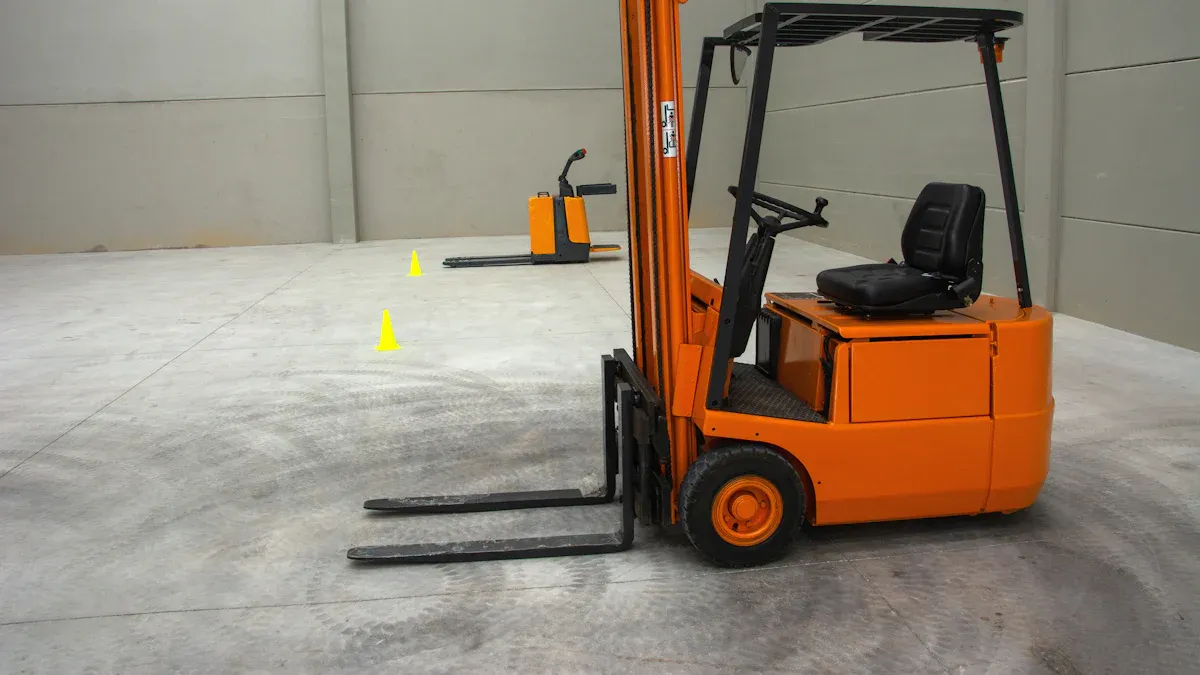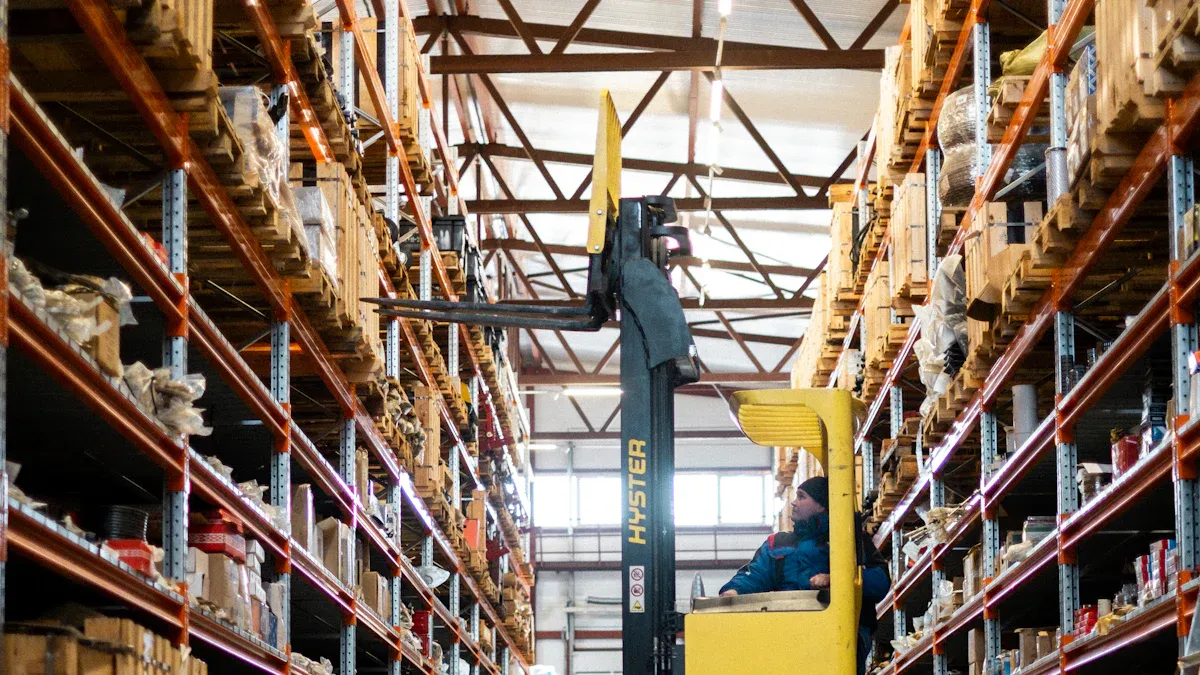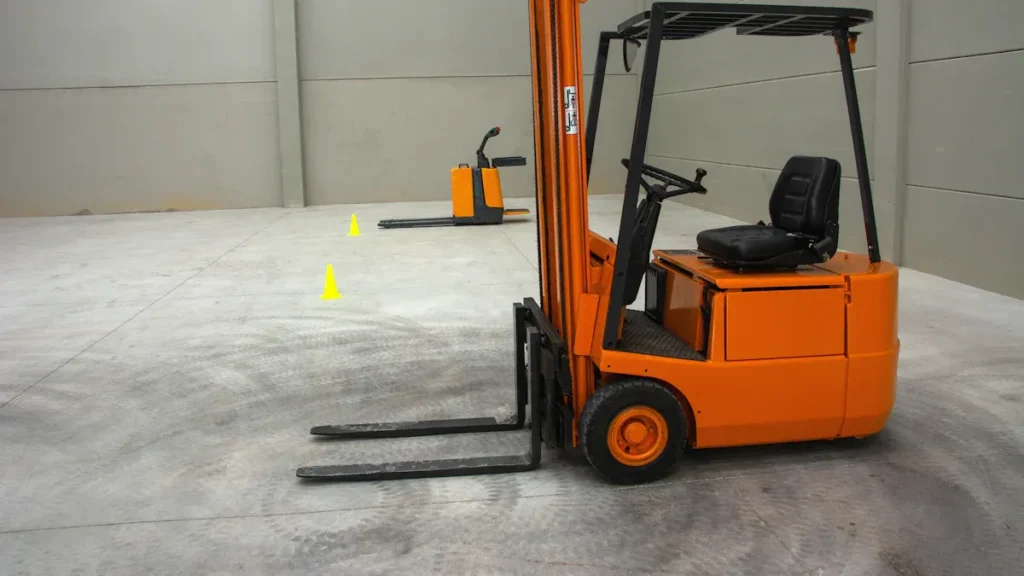
Forklifts are important machines used to move heavy items, and understanding the various forklift types is essential for selecting the right one for each job. They are needed in places like warehouses, construction sites, and stores. These machines make work easier and faster by lifting heavy loads, saving time and reducing the need for hard physical work. Experts say forklifts will grow in popularity, with the market reaching $230.45 billion by 2033. North America is leading because of its strong industries, while Europe is focusing on better technology and automated warehouses. Knowing the different forklift types helps you pick the best one for each job, making work smoother and improving productivity.
Key Takeaways
Learn about forklift types to pick the best one. Each type works well for certain jobs.
Think about how much weight and height you need. Match these to stay safe and work efficiently.
Check the ground and area where it will be used. Pick forklifts for indoor or outdoor spaces based on your needs.
Choose the right power for your forklift. Electric ones are quiet and green, while diesel and gas are good for tough outdoor jobs.
Plan for buying and fixing forklifts. Electric ones cost more first but save money later.
Common Forklift Types and Their Features

Counterbalance Forklifts
Counterbalance forklifts are one of the most popular forklift types. They have a simple design with a heavy weight at the back. This weight balances the load being lifted at the front. These forklifts work best indoors, like in warehouses or factories. Smooth floors make them easy to drive and control.
Tip: Use counterbalance forklifts for lifting heavy pallets or large items. They are stable and work efficiently.
These forklifts are great for jobs needing careful material handling. They are useful for loading trucks, stacking goods, and moving items over short distances.
Reach Trucks
Reach trucks are special forklifts made for high shelves. They have a slim body and a tall mast to reach high places. These forklifts are perfect for tight spaces in warehouses. Unlike counterbalance forklifts, reach trucks are only for indoor use. They work well in narrow aisles.
Key features of reach trucks include:
Extended Reach: Their tall mast helps grab items from high shelves.
Compact Design: Their small size makes them easy to move in tight spots.
Note: Reach trucks are not good for outdoor use because of their low ground clearance.
If your warehouse needs frequent stacking or picking from high shelves, reach trucks are a smart choice.
Pallet Jacks
Pallet jacks are the simplest and cheapest forklift types. They are made for moving pallets over short distances. You’ll see them in small warehouses, stores, and distribution centers.
There are two main kinds of pallet jacks:
Manual Pallet Jacks: These are hand-operated, light, and simple to use.
Electric Pallet Jacks: These run on batteries, making them easier and faster to use.
Tip: If you need to move pallets often but don’t lift heavy loads, pallet jacks are a budget-friendly option.
Pallet jacks can’t lift items very high, but they are affordable and easy to use. They are a helpful tool for small material handling tasks.
Order Pickers
Order pickers are forklifts made for picking single items. Unlike forklifts that lift whole pallets, these pickers grab specific products. They are great for warehouses handling many small orders.
Key Features of Order Pickers:
Elevating Operator Platform: The platform lifts with the forks to grab items.
Compact Design: Their slim shape fits well in tight aisles.
High Reach Capability: They can reach up to 30 feet high shelves.
Tip: Use order pickers for frequent item picking from tall racks. They save time and reduce effort.
Order pickers are common in e-commerce warehouses needing speed and accuracy. They also help with inventory tasks by accessing items without moving pallets. These machines work best indoors on smooth floors.
Rough Terrain Forklifts
Rough terrain forklifts are made for tough outdoor jobs. They have big tires and strong engines for uneven ground. These forklifts are perfect for lifting heavy loads outside.
Key Features of Rough Terrain Forklifts:
Durable Tires: Big tires grip well on rough surfaces.
High Ground Clearance: This helps them move over bumpy ground safely.
Robust Lifting Capacity: They can lift over 6,000 pounds easily.
Note: These forklifts are great for construction, farming, and logging on rough land.
Rough terrain forklifts carry building materials, logs, or heavy tools outdoors. Their strong build keeps them steady on slopes or rocky areas. They are not good for indoor use because of their size and weight.
Specialized Forklift Types for Unique Applications

Side Loader Forklifts
Side loader forklifts are made for moving long items. They lift from the side, not the front. This makes them great for narrow spaces. They can carry things like pipes, wood, and steel beams easily.
Key Features:
Sideways Lifting: Load and unload without turning the forklift.
Compact Build: Fits well in small, tight areas.
Tip: Use side loaders in places with little space and long materials.
These forklifts are helpful in construction and timber work. They are perfect for moving big items in tight spots. This makes them a useful tool for many jobs.
Telescopic Forklifts
Telescopic forklifts, or telehandlers, work like forklifts and cranes. They have a boom arm that stretches out for extra height. You can add tools like buckets or forks to do different tasks.
Key Features:
Extendable Boom Arm: Reach high places with ease.
Attachment Compatibility: Use different tools for various jobs.
Note: Telehandlers are great for lifting heavy things to high spots.
Telehandlers are common in farming and building work. They are strong and work well outside. Whether moving hay or building supplies, they are very useful.
Articulated Forklifts
Articulated forklifts are changing how warehouses work. They have a body that bends, so they turn easily in tight spaces. Some even use smart technology to work better and faster.
Key Features:
Pivoting Chassis: Turns easily in small spaces.
AI Integration: Plans routes and adjusts to changes.
Benefits of Automation in Articulated Forklifts:
Safer by reducing mistakes.
Speeds up work in warehouses.
Saves money by needing less manual labor.
Tip: Pick articulated forklifts for jobs needing speed and accuracy.
These forklifts are popular in North America. They handle tricky warehouse tasks well. Their smart systems keep them running smoothly and save time, making them a great choice for busy businesses.
Industrial Forklifts
Industrial forklifts are strong machines made for tough jobs. They are used in big factories, warehouses, and industrial sites. These forklifts move heavy items that smaller forklifts cannot lift. Their sturdy build and ability to lift heavy loads make them very useful.
Key Features of Industrial Forklifts:
High Lifting Capacity: They can lift between 10,000 and 30,000 pounds or more. This makes them great for moving heavy machines, steel rolls, or big containers.
Durable Construction: Strong frames and engines help them handle hard tasks.
Versatile Attachments: You can add tools like clamps or fork extensions to carry different items.
Tip: Use industrial forklifts for moving very large or heavy objects.
Industrial forklifts work well in places where strength and dependability matter. For example, they are great for loading shipping containers at ports. Factories use them to move raw materials or finished goods. These forklifts save time and boost productivity by handling heavy loads easily.
Applications of Industrial Forklifts:
Manufacturing: Carry metal sheets or big molds.
Shipping and Logistics: Quickly load and unload freight containers.
Construction: Move heavy building items like concrete blocks or steel beams.
Recycling Centers: Lift and transport large bundles of recyclable materials.
Industrial forklifts can work indoors and outdoors. Many models have strong tires and high ground clearance for rough outdoor surfaces. This makes them useful in many industries.
When picking an industrial forklift, think about your needs. Consider the weight of the items you move and how high you need to lift them. Also, check if the forklift can handle the ground it will work on. Choosing the right forklift ensures safe and easy material handling.
Factors to Consider When Choosing Forklift Types
Lifting Capacity and Height
Picking the right forklift means knowing its lifting power and height. Each forklift has a plate showing its maximum weight limit. Check this plate to see if it fits your needs.
Forklifts come with different lifting abilities and heights. For example:
Forklift Type | Minimum Capacity | Maximum Capacity | Maximum Lift Height |
|---|---|---|---|
Small Forklifts | 600 kg | 3 tons | Varies |
Large Forklifts | N/A | 52 tons | Varies |
If you need to lift heavy items or stack high, choose a forklift with more power and reach. Ignoring these limits can cause accidents or damage the machine.
Tip: Match the forklift’s lifting power and height to your job needs. This keeps work safe and smooth.
Indoor vs. Outdoor Use
Forklifts are made for certain places. Indoor forklifts, like pallet jacks, work well on flat floors. They are small and easy to move, perfect for warehouses. Outdoor forklifts, like rough terrain ones, have strong tires for uneven ground.
Look at your workspace before picking a forklift. Indoors, choose quiet forklifts with low emissions. Outdoors, pick models with tough engines and weatherproof parts.
Note: Indoor forklifts don’t work well outside, and outdoor ones can harm indoor floors.
Terrain and Surface Conditions
The ground type matters when choosing a forklift. Smooth floors need forklifts with small tires and low clearance. Rough ground needs forklifts with big tires and strong frames.
For slopes, gravel, or mud, rough terrain forklifts are best. They stay steady and grip the ground well. Indoors, forklifts with special tires protect floors from marks.
Tip: Check your workspace surface to avoid problems and work better.
Power Source Options
Picking the right power source affects cost and efficiency. Forklifts can run on electric batteries, diesel, or gas. Each type has its own benefits. Knowing these helps you choose wisely.
Electric Forklifts: These use rechargeable batteries like lithium-ion or lead-acid. Lithium-ion batteries save 40% more energy than lead-acid ones. They are better for long-term savings. Electric forklifts cost less to run than diesel ones. Using them for 2,000 hours a year can cut emissions in 12-18 months. This makes them a greener choice for eco-friendly businesses.
Diesel Forklifts: Diesel forklifts are great for outdoor and heavy jobs. They have strong lifting power, perfect for construction or ports. But they create more pollution and need regular upkeep.
Gas-Powered Forklifts: These forklifts use propane or natural gas. They balance power and lower emissions. They work well indoors and outdoors. Gas forklifts refuel fast, so there’s less waiting time.
Tip: Use electric forklifts indoors for quiet, clean work. For outdoor or tough jobs, diesel or gas forklifts are stronger.
Budget and Maintenance
Your budget matters when picking a forklift. Electric forklifts cost more upfront but are cheaper to run. Diesel and gas forklifts cost less to buy but need more repairs over time.
Think about maintenance when buying. Electric forklifts need battery care, like charging and checking. Diesel and gas forklifts need oil changes and engine checks often.
Note: A forklift with low maintenance needs saves money and time.
By balancing your budget with future costs, you can find the right forklift for your needs.
Matching Different Types of Forklifts to Industry Needs
Warehousing and Distribution
Warehouses need forklifts to move items quickly and easily. Picking the right forklift depends on the space and tasks. Tight aisles need small forklifts like reach trucks or order pickers. These forklifts work well in narrow spaces and on high shelves. For bigger warehouses, counterbalance forklifts are great for loading and unloading pallets.
Things to think about:
Load Capacity: Make sure the forklift can lift your items.
Lift Height Capacity: Choose forklifts that can safely reach tall shelves.
Propulsion Systems: Electric forklifts are quiet and clean, perfect for indoor use.
Key Insights | Beschreibung |
|---|---|
Match forklifts to warehouse size, aisle width, and tasks. | |
Propulsion Systems | Electric and gas engines improve safety and efficiency. |
Technological Advancements | Automation and smart systems save time and reduce labor needs. |
Tip: Buy forklifts with smart features to save time and money.
Construction and Heavy-Duty Applications
Construction sites need strong forklifts for rough ground and heavy loads. Rough terrain forklifts and telescopic forklifts are best for these jobs. Their big tires and strong engines keep them steady on uneven land. Telescopic forklifts can lift items high with their extendable arms.
Key points to consider:
Terrain Conditions: Pick forklifts with big tires and high clearance for outdoor work.
Engine Type: Gas or diesel engines give the power needed for tough jobs.
Training: Operators need proper training to work safely and efficiently.
Note: Telescopic forklifts are great for lifting and crane-like tasks.
Retail and Small-Scale Operations
Retail stores and small businesses use small forklifts like pallet jacks and order pickers. These forklifts are good for tight spaces and light loads. Manual pallet jacks are cheap and easy to use. Electric ones save time and effort for busy tasks.
Keep in mind:
Space Constraints: Small forklifts fit well in tight storage areas.
Budget: Pallet jacks are affordable for small businesses.
Ease of Use: Electric models make work faster and less tiring.
Tip: Use order pickers to grab items quickly in stockrooms.
Retail forklifts help businesses stay organized and save time. They make managing inventory easier and reduce hard physical work.
Agriculture and Outdoor Work
Forklifts are helpful for farming and outdoor jobs. They move heavy things like hay, feed, or farm tools. These machines save time and make work easier.
Key Features of Agricultural Forklifts:
All-Terrain Tires: Tires grip dirt, grass, or gravel well.
Weather-Resistant Design: Built to handle rain, dust, and heat.
High Lifting Capacity: Can lift heavy items like big containers or equipment.
Tip: Use rough terrain forklifts for farms with uneven ground.
Benefits of Forklifts in Agriculture:
Improved Efficiency: Move items quickly without much effort.
Versatility: Add tools like buckets to do different tasks.
Safety: Prevent injuries by using forklifts instead of lifting by hand.
Forklifts are very useful during harvest time. They carry crops, load trucks, and stack goods in storage. Telescopic forklifts can reach high places or load tall trailers easily.
Applications in Outdoor Work:
Landscaping: Move soil, plants, or tools around large areas.
Forestry: Transport logs or gear over rough ground.
Construction: Carry bricks, cement, or other building materials.
Note: Train workers to use forklifts safely outdoors.
🚜 Forklifts made for farms and outdoor jobs make work faster. Picking the right forklift improves safety and helps you get more done.
Picking the right forklift means knowing what your job needs. Different forklifts have special features for certain tasks. Think about things like how much weight it can lift, the type of ground it will work on, and what powers it. Choosing the right forklift for your workspace makes work faster and safer. The right machine helps you get more done and makes moving items easier.
FAQ
What is forklift certification, and why is it important?
Forklift certification shows you know how to use forklifts safely. It helps prevent accidents and follows safety rules. Many jobs require it to meet workplace standards.
Can forklifts be used for both indoor and outdoor tasks?
Ja, forklifts can work indoors and outdoors. Indoor ones, like pallet jacks, are good for smooth floors. Outdoor ones, like rough terrain forklifts, handle bumpy ground. Pick the right type for your workspace.
How do I choose the right forklift for my business?
Think about what you need to lift, your budget, and the ground type. Industrial forklifts are best for heavy items. Reach trucks work well in small spaces. Match the forklift to your tasks.
Are electric forklifts better than diesel ones?
Electric forklifts are quiet and better for the environment. They work well indoors. Diesel forklifts are stronger and good for outdoor jobs. Choose based on your needs and the job location.
Do forklifts require regular maintenance?
Ja, forklifts need regular care to stay safe and work well. Electric ones need battery checks. Diesel ones need engine servicing. Taking care of them makes them last longer.

